Reach & Punch: RADM Manazir On The Future Of Naval Airpower
Posted on
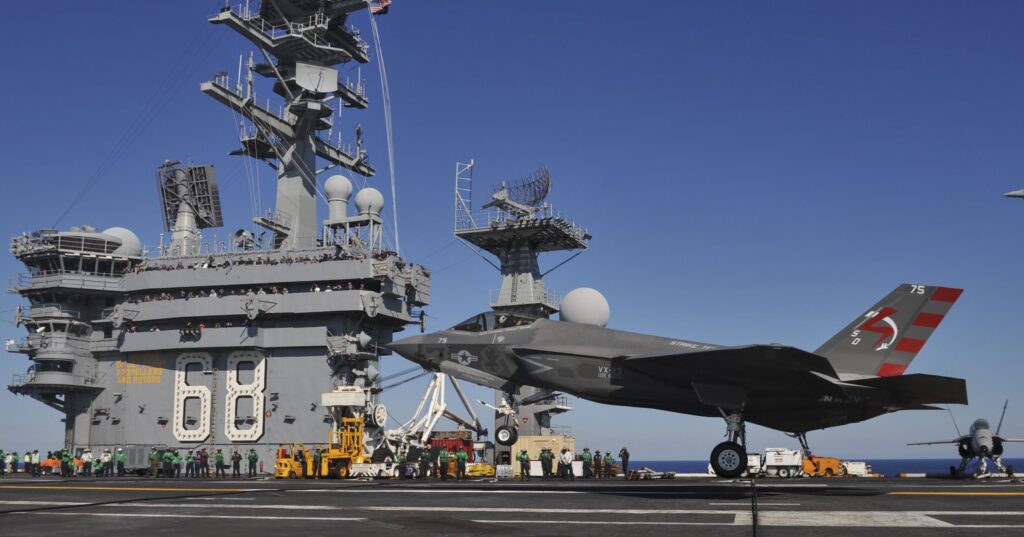
A Navy F-35C conducts its first-ever arrested landing aboard the carrier USS Nimitz
The sea and the sky above it are becoming more dangerous for US forces. Even terrorist groups like Hezbollah and the Islamic State have access to anti-ship and anti-aircraft missiles, let alone great powers like Russia and China. But the US Navy and Marines recognize this “anti-access/area denial” challenge and are reshaping their forces to meet it. We had a chance recently to discuss the way ahead with the Navy’s Director of Air Warfare, Rear Admiral Michael Manazir.
Manazir’s perspective is much wider than the evolving carrier air wing and the new Ford-class carrier. It is about how the sea services overall were being transformed by the ability to work more effectively with the other US services and other nations. Too often in defense discussions, focus is on a particular platform — a ship, a plane, a vehicle — and not on how new platforms work with what we already have to enhance the force as a whole.
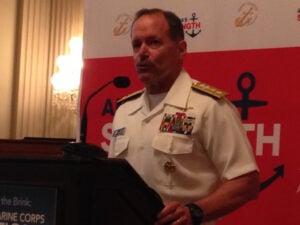
Rear Adm. Mike Manazir
Networked Training For Networked Warfare
That integrated force has to start with training. When we visited the Naval Strike and Air Warfare Center at Fallon, Nevada, we discovered that the US Navy had become a global hub of tactical learning. A carrier strike group in combat can now reach back to instructors at NSAWC to improve combat tactics almost real time. Conversely,, the air wing training at Fallon to go on the next carrier deployment was working directly with real time lessons from their counterparts currently deployed.
Visits to the advanced combat training units of the US power projection services — Fallon, Marine Air Weapons and Tactics Squadron (MAWTS-1) at Yuma, and the US Air Force Weapons School at Nellis — underscored that the services are using new technology to work more closely with each other and coalition partners. Both the US and allies are building Live-Virtual-Constructive Training (LVCT) facilities, which can allow for training against adversaries over much greater distances and under much more intense conditions than is possible by simply flying on single service training facilities. For example, when we visited Australia’s Richmond Air Base this summer, we witnessed the Royal Australian Air Force conducting LVCT with the US and Canadian air forces using audio and visual links directly from Richmond to Nellis.
“LVCT will enable us to train in a more robust environment than we are on our current ranges that are geographically constrained and currently do not have the full high-end threat replicated,” Manazir told us. “LVCT will allow us to train to the full capabilities of our platforms across a variety of security environments and do so without exposing our training process to an interested adversary.”
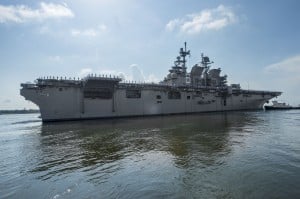
LHA-6, the USS America
Carriers & Amphibs: Network Hubs At Sea
For Rear Adm. Manazir, the new ships coming online plug into a global network, allowing forward forces to reach back to the wider fleet, other services, allies, or supporting agencies in the United States itself.
The amphibious fleet in particular is evolving beyond the traditional role of the Amphibious Ready Group. With new ships like the LHA-6 America and new aircraft like the F-35B Joint Strike Fighter, it provides a powerful persistent presence which can deal with a much wider range of tasks..
“The Marine Corps has grown in capability from being naval infantry to now having the capability to come from the sea with high-end meshed, networked, honeycombed, resilient capability, with an array of options depending on how you integrate the force,” Manazir told us. “The sea base itself has a powerful ability strategically to wage war because you don’t need a permission slip from a foreign power to use their bases. The United Stated Navy and the United States Marine Corps singly in the world have retained and modernized the sized capability that allows one to fight a nation with our force rather than just fight another naval force.”
There’s also the new large-deck carriers, the Ford class. Rear Admiral Manazir talked about the USS Ford as a contributor to the expanded battlespace, not simply the center of a classic carrier strike group.
“The USS Ford is a 21st century naval infrastructure asset, which lives off and further enables the transformation of the air wing. It’s a facilitator for all the things you’re going to do off the flight deck,” Manazir said, describing a shift in thinking about the carrier. It’s not just a deck which can fly X number of aircraft: It’s a moving hub of an extended strike enterprise, which can work with the Air Force and coalition partners.
“The focus is upon the carrier as a moving epicenter for a netted capability with the joint and coalition force. It is not about counting the number of airplanes on the deck or projecting the future existence of paper airplanes,” Manazir said. “It is about the air wing we are building and how it will operate with the transformed joint and coalition forces we are collectively modernizing.”
“The approach is to have force structure flexibility with an interconnected extended battlespace,” he said. “You can operate as a separate force package, or as a federated force when you are connected but can plug and unplug. You can be interoperable, integrated or interdependent, depending on time, circumstances and mission.”
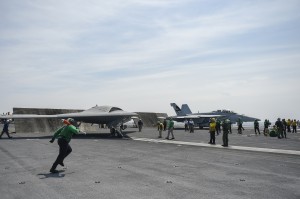
The X-47 drone and a manned F/A-18 Super Hornet operating side by side on the USS Theodore Roosevelt during an August 17 test.
The Future Air Wing: Network In the Sky
“What the Ford-class, the Joint Strike Fighter, and future unmanned platforms bring is the ability to pull the information in and be an epicenter of an enlarged and extended reach for the joint and coalition force,” Manazir said. With its ability to push data back to the ships and across the international coalition of F-35 operating nations, the F-35 is more than just a new strike fighter: It is part of fundamental change in the way the sea services operate across an extended, integrated battlespace.
“We are doing what Bayesian theory talks about, namely we are providing more and more information to get closer to the truth in targeting or combat situation. One can reduce that fog of war by increased understanding of what actual truth is; [then] you’re going to have better effects,” said Manazir. “This is why the technology that the F-35 brings to the fight is so crucial.”
“With the fifth generation aircraft and their sensors and fused data, you can cover a much greater swath of combat space than with legacy aircraft, and as we sort through how to integrate unmanned systems with F-35s, we will be able in a single operational unit to cover significant combat space,” Manazir said. “You are looking at exponential growth in coverage capabilities to inform the process of generating the combat effects, which you want in that extended battlespace, and the growth in the ability to generate better target information will allow us to execute strikes within our rules of engagement.”
“With Block 3F software in the airplane, we will have data fusion where you transform data information to knowledge enabling greater wisdom about the combat situation,” he continued. “The processing machines in the F-35 provide enough of the fusion so that the pilot can now add his piece to the effort. This enables the ships to enhance their ability to operate in the networks and to engage with the air fleet in dynamic targeting at much greater distance.”
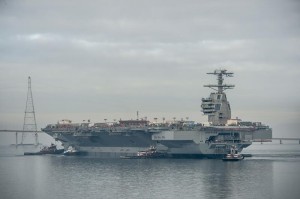
The new carrier USS Ford is afloat but still unfinished.
The Honeycomb Goes To War
Overall the sea services are expanding their reach, remote sensing and precision strike capabilities. They do so by being networked into an operational honeycomb of interconnected forces with reach, range and lethality against air, sea, space, and land-based targets.
“It is about reach, not range, for the honeycomb-enabled expeditionary strike group,” Manazir said. “The F-35 is a key enabler of this shift, but it is part of an overall effort to operate in the expanded battlespace.”
As the sea services evolve, the decade ahead is not a repeat of the past 15 years. It is not about prolonged ground combat and counterinsurgency. The technology and training exist to insert force to achieve discrete and defined objectives, to maneuver in the extended battlespace, and to work with allies and joint forces to prevail across the full range of military conflict in any part of the globe.
Subscribe to our newsletter
Promotions, new products and sales. Directly to your inbox.
